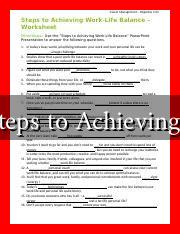-
Table of Contents
What are the First Steps to Achieving Work-Life Balance?
In today’s fast-paced world, achieving a work-life balance has become a significant challenge for many individuals. The constant demands of work, coupled with personal responsibilities, can lead to stress, burnout, and a decline in overall well-being. However, taking the first steps toward a balanced life is not only possible but essential for long-term happiness and productivity. This article explores practical strategies to help you achieve a healthier work-life balance.
Understanding Work-Life Balance
Work-life balance refers to the equilibrium between personal life and professional responsibilities. It is about finding a sustainable way to manage your time and energy so that neither work nor personal life suffers. According to a survey by the American Psychological Association, 61% of adults reported that work is a significant source of stress in their lives. This statistic underscores the importance of prioritizing balance.
Step 1: Assess Your Current Situation
The first step toward achieving work-life balance is to assess your current situation. Understanding where you stand can help you identify areas that need improvement. Consider the following:
- Time Audit: Track how you spend your time over a week. This includes work hours, family time, leisure activities, and self-care.
- Identify Stressors: Recognize what aspects of your work and personal life cause stress. Is it long hours, lack of support, or personal obligations?
- Evaluate Satisfaction: Rate your satisfaction in various areas of your life, such as career, relationships, health, and personal growth.
By conducting this assessment, you can pinpoint specific areas that require attention and improvement.
Step 2: Set Clear Boundaries
Establishing boundaries is crucial for maintaining a healthy work-life balance. Here are some strategies to consider:
- Designate Work Hours: Set specific start and end times for your workday. Communicate these hours to your colleagues and family.
- Create a Dedicated Workspace: If you work from home, establish a designated workspace that is separate from your personal areas.
- Limit After-Hours Communication: Avoid checking emails or taking work calls after hours to protect your personal time.
By setting clear boundaries, you can create a more structured environment that allows for both productivity and relaxation.
Step 3: Prioritize Self-Care
Self-care is often overlooked in the pursuit of work-life balance. However, taking care of your physical and mental health is essential. Consider incorporating the following self-care practices into your routine:
- Regular Exercise: Aim for at least 30 minutes of physical activity most days of the week. Exercise can reduce stress and improve mood.
- Mindfulness and Meditation: Practicing mindfulness can help you stay present and reduce anxiety. Apps like Headspace or Calm can guide you through meditation.
- Quality Time with Loved Ones: Make time for family and friends. Engaging in social activities can provide emotional support and enhance your well-being.
Investing in self-care not only benefits you but also positively impacts your work performance and relationships.
Step 4: Seek Support
Don’t hesitate to seek support from others. Whether it’s your employer, family, or friends, having a support system can make a significant difference. Here are some ways to seek support:
- Communicate with Your Employer: Discuss your workload and any challenges you face. Many employers are willing to accommodate flexible working arrangements.
- Join Support Groups: Consider joining groups or forums where you can share experiences and strategies with others facing similar challenges.
- Professional Help: If stress becomes overwhelming, consider speaking with a mental health professional for guidance and support.
Having a support network can provide encouragement and practical solutions to help you navigate challenges.
Conclusion
Achieving work-life balance is a continuous journey that requires self-awareness, boundary-setting, self-care, and support. By taking these first steps, you can create a more fulfilling and balanced life. Remember, it’s not about achieving perfection but rather finding a sustainable way to manage your responsibilities and well-being. As you implement these strategies, you may find that both your personal and professional life improve significantly, leading to greater satisfaction and happiness.
For more insights on work-life balance, consider visiting American Psychological Association.




